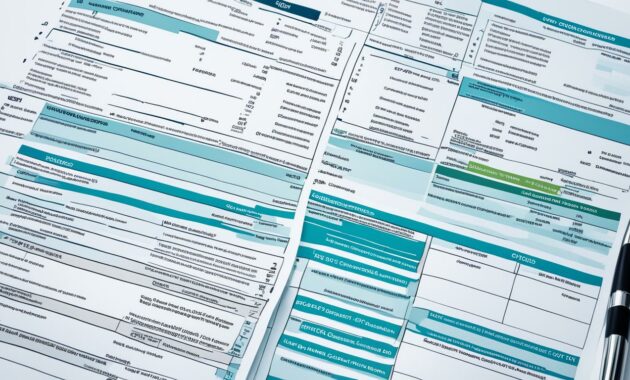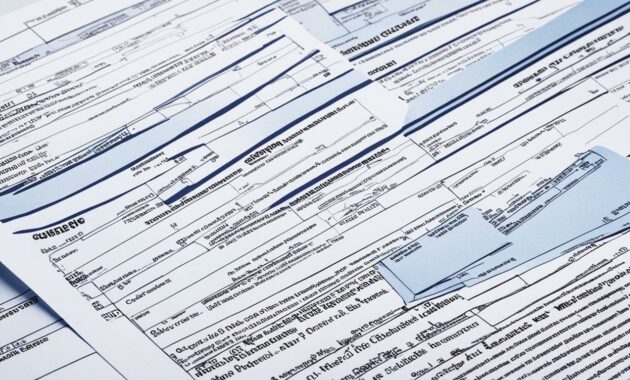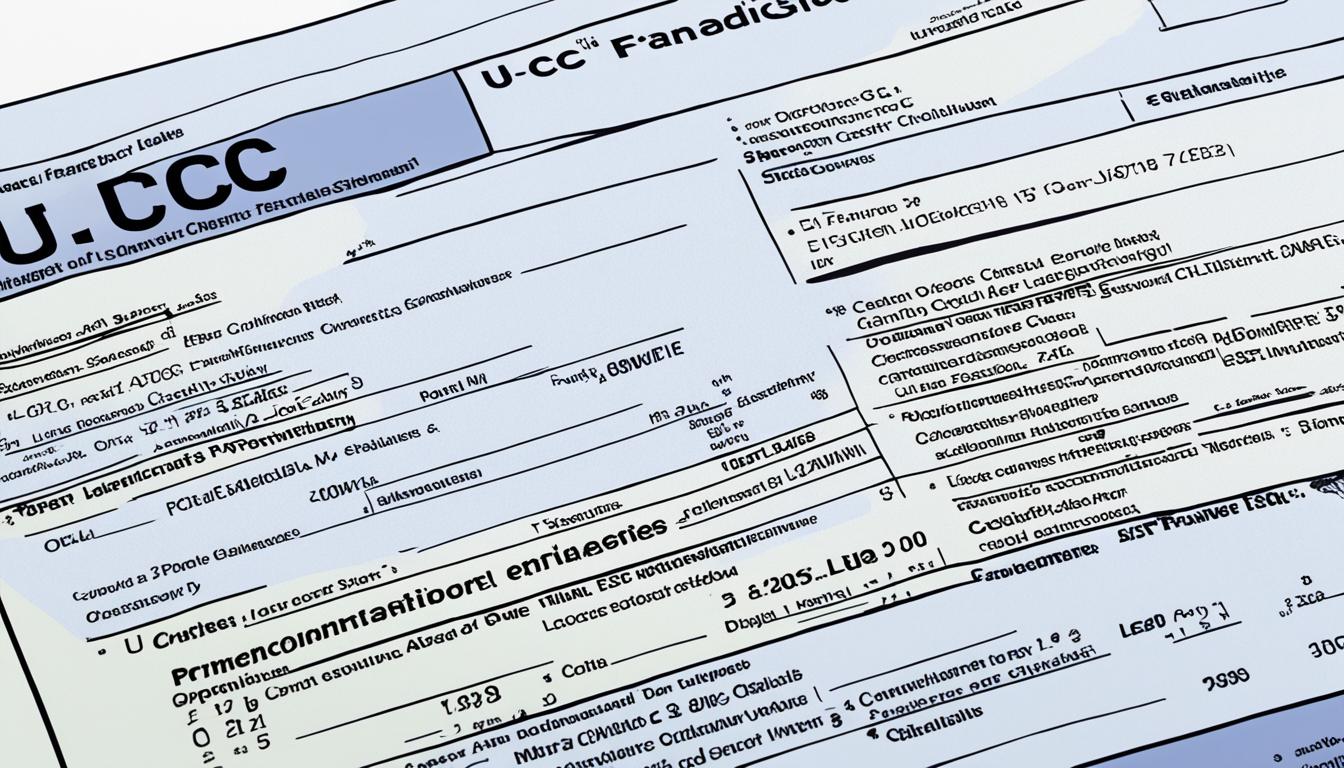A UCC-Uniform Commercial Code-1 (UCC-1) statement is a key form. It’s filed by creditors to show they have rights over a debtor’s personal property. These effective financing statements show a creditor’s security interest in things like stock, tools, and money owed to the business. It works like a mortgage but for business assets. The UCC-1 statement is crucial in secured transactions. It sets the rules for who gets paid first if multiple creditors are involved with the same debtor.
According to the Uniform Commercial Code (UCC), businesses must do UCC-1 filings for loans. This helps avoid fights between creditors over the same collateral. These filings let everyone know who has a claim on the assets. This gives debtors a clear way to show what’s available for new financing. Being accurate and following UCC rules is key. It makes sure the effective financing statement is legally solid and can be enforced.
What is a UCC-1 Financing Statement?
Definition and Purpose
A UCC-1 financing statement is a legal notice. It’s filed by creditors to declare their rights to personal properties when debtors don’t pay back business loans. The Uniform Commercial Code (UCC) requires these to show what assets are used to secure the loan.
Key Components
It includes the debtor’s detailed information and a description of the assets that secure the loan. Collateral can be things like real estate, cars, equipment, or stocks. When filing, New York needs more info than other places.
To perfect a secured interest, use UCC Financing Statements or have possessions under purchase money security. For consumer goods, a special rule applies. It doesn’t need a Financing Statement to be perfected. Yet, the statement must be accurate. A wrong statement could still work if it doesn’t mislead.
If you file within 20 days of a non-consumer good delivery, it helps your claim. You can also perfect by holding or controlling the asset. This is another way to make sure you’re first in line.
For all business loans, you need UCC-1 statements. They’re under the Uniform Commercial Code. These state who has rights to what assets in case of a loan default.
Types of Effective Financing Statements
In the world of secured transactions, two main types of financing statements work well. They are the specific collateral UCC-1 statement and the blanket lien UCC-1 statement. Each type gives lenders a different level of security.
Specific Collateral UCC-1 Statements
Specific collateral UCC-1 statements are often used in real estate or equipment deals. They make sure lenders have the first right to the properties or special items like equipment. With this statement, lenders know they come first if there’s a claim against the assets.
Blanket Lien UCC-1 Statements
On the other hand, blanket lien UCC-1 statements let lenders claim an interest in many of the debtor’s assets. This includes any new assets the debtor gets too. Lenders like this type because it covers more items. It helps them protect their investment better.
| Financing Statement Type | Collateral Coverage | Lender Preference |
|---|---|---|
| Specific Collateral UCC-1 | Real estate, equipment, or other specific assets | First-priority secured interest in the collateral |
| Blanket Lien UCC-1 | Broad range of the debtor’s current and future-acquired assets | Comprehensive secured interest in the debtor’s asset pool |
Which statement to use, specific or blanket, depends on many things. The lender’s choice is based on how much risk they can take, the deal’s type, and what the financing needs. Choosing carefully helps protect the lender’s rights well.

“A properly executed and filed UCC-1 financing statement is a critical tool in establishing a lender’s secured interest and priority position in the debtor’s collateral.”
Perfecting an Effective Financing Statement
To make a UCC-1 financing statement perfect, lenders file it with the state where the debtor is based. This is often the secretary of state’s office. This act is crucial for the lender to claim rights to the debtor’s property securely. The state will then give a time-stamp and a special number to the filing.
Filing Requirements
How a lender perfects their claim can change who gets paid first. Generally, a UCC-1 goes behind real estate when filed in the central index. But, if it’s a “fixture filing,” it jumps ahead of other real estate claims. There are times when different rules apply, like for purchase-money security interests on fixtures.
Priority Rules
The UCC’s priority rules decide which lender comes first in getting paid. These guidelines sort out who has the right to the same properties or items. When the UCC filing is done matters, along with what kind of assets are involved. Also, if the UCC filing was done correctly can also play a big part.
Getting the UCC-1 right is key for lenders. Knowing the filing and priority details ensures the lender’s stake in the debtor’s items is protected. This helps make the financing statement do its job well.
Impact of an Effective Financing Statement
Filing a UCC-1 financing statement lets creditors protect their loans by using their customer’s personal assets. This makes the lender a secured creditor. It means they get paid back first if a customer can’t pay or goes bankrupt. They can then take the assets used as collateral to cover their loss.
Having a valid financing statement gives lenders important rights. A filed statement usually lasts for five years unless stated differently. For some deals, like public finance or manufactured homes, it can last up to 30 years. You prolong its effect by filing an update about six months before it runs out.
Even if the item used as security is sold or lost, the statement can stay valid. But if the info is wrong, it might not protect the lender’s rights. The law allows for some exceptions, though. Then, a corrected filing might keep the statement in force for certain cases.
In states where you file with a central agency for farm goods, rules about filing are strict. If you don’t follow these, buyers of farm products might not have to pay back the loan taken by the seller. It’s important for lenders to know these state-specific rules.
“The effectiveness of a financing statement is crucial for lenders’ rights and protections.”

To recap, a properly done financing statement is a key tool for lenders. It puts them ahead in line to get paid back. It’s vital for lenders to fully understand how to file and keep these statements updated. It helps protect their loans and increase their chances of getting their money back in tough times.
Renewal and Termination of an Effective Financing Statement
The UCC-1 financing statement is key in a secured transaction but only lasts five years. Lenders need to update it before the deadline. They can file a continuation statement during the last six months to keep it going for five more years.
When a loan gets fully repaid, lenders can end the financing statement with a UCC-3 statement. If they don’t do this, they might lose their claim on the item.
Lenders must watch the dates on their UCC-1 filings and act when needed. If they forget, they might lose their rights. This is really important to avoid issues if the borrower goes bankrupt.

